Evolution of Management Theory and Practice: A Comprehensive Overview
VerifiedAdded on 2023/01/13
|8
|2331
|84
Report
AI Summary
This report provides a comprehensive overview of the evolution of management theory and practice, spanning from the industrial revolution to the post-industrial era. It begins by introducing the core concepts of management and the organizational structures that facilitate resource allocation and goal attainment. The main body delves into the transformation of management practices during the industrial revolution, highlighting the shift from traditional methods to scientific management, administrative management, and bureaucratic theories. The report examines the contributions of key figures such as F.W. Taylor, Henry Fayol, and Max Weber, and analyzes the strengths and weaknesses of each approach. It then explores the emergence of neoclassical theories, including human relations and behavioral science approaches, emphasizing the importance of employee needs and motivation. Finally, the report discusses the evolution of management practices in the post-industrial era, including quantitative, systems, contingency, and operational approaches, and concludes by summarizing the key takeaways and the impact of these theories on modern management practices.
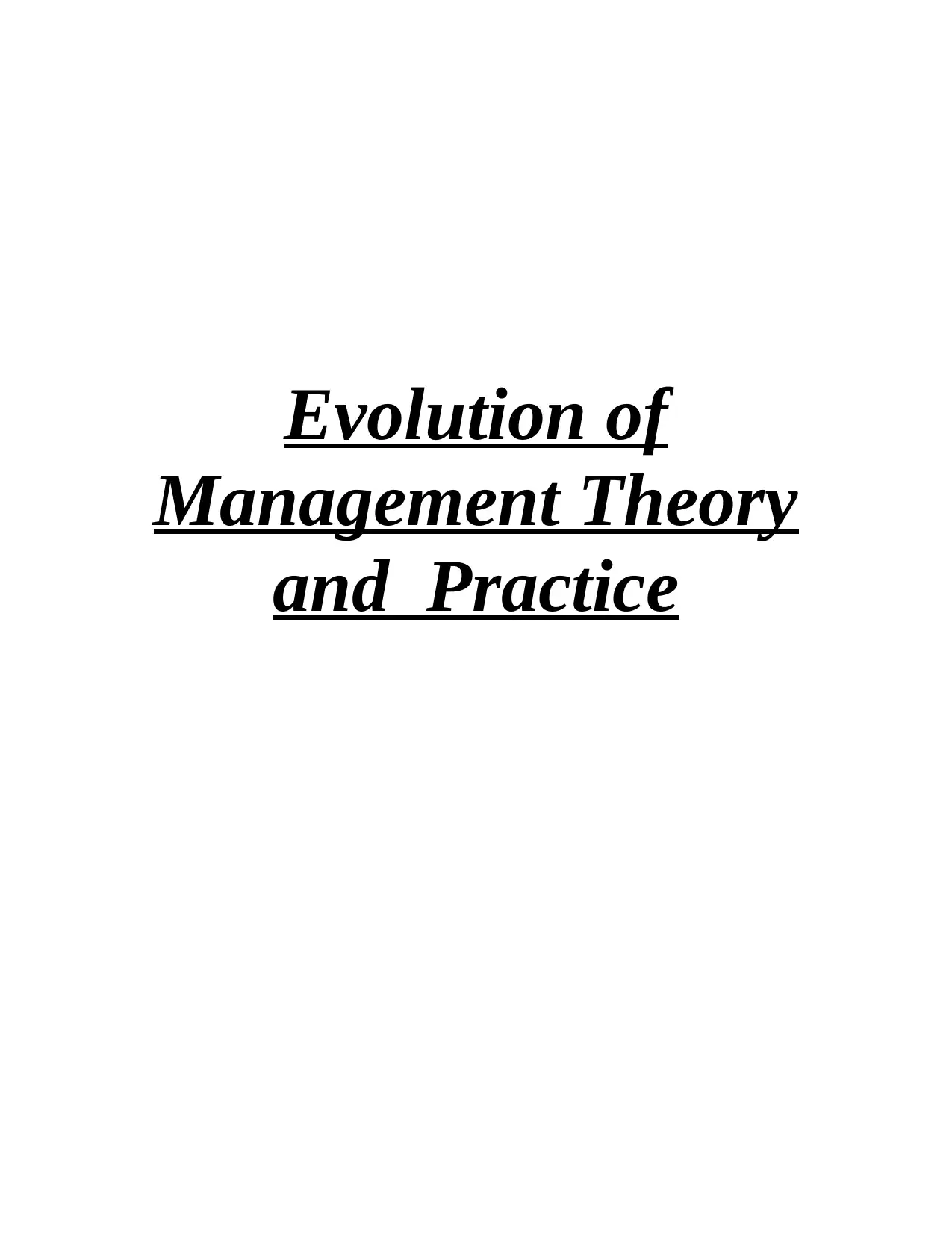
Evolution of
Management Theory
and Practice
Management Theory
and Practice
Paraphrase This Document
Need a fresh take? Get an instant paraphrase of this document with our AI Paraphraser
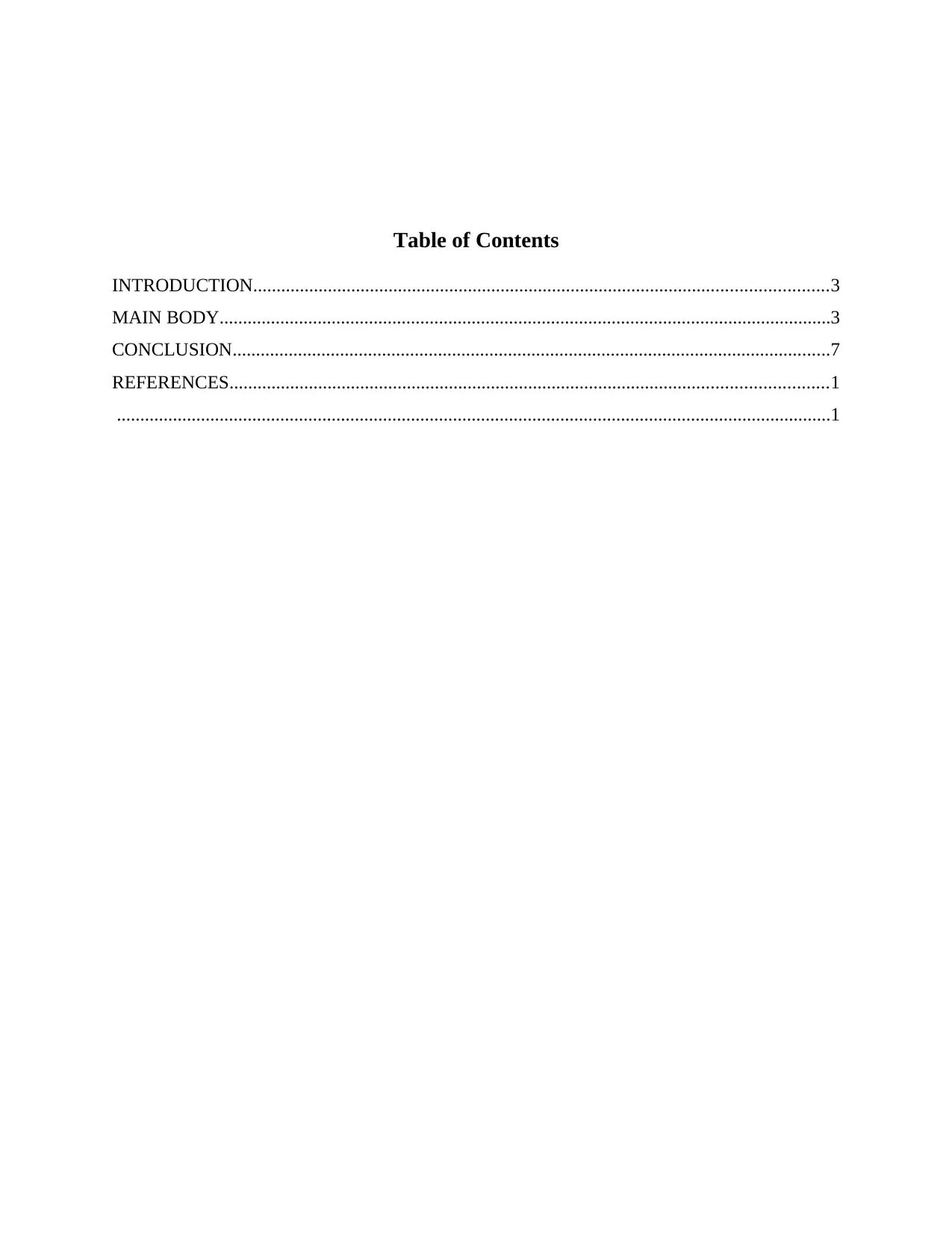
Table of Contents
INTRODUCTION...........................................................................................................................3
MAIN BODY...................................................................................................................................3
CONCLUSION................................................................................................................................7
REFERENCES................................................................................................................................1
.........................................................................................................................................................1
INTRODUCTION...........................................................................................................................3
MAIN BODY...................................................................................................................................3
CONCLUSION................................................................................................................................7
REFERENCES................................................................................................................................1
.........................................................................................................................................................1
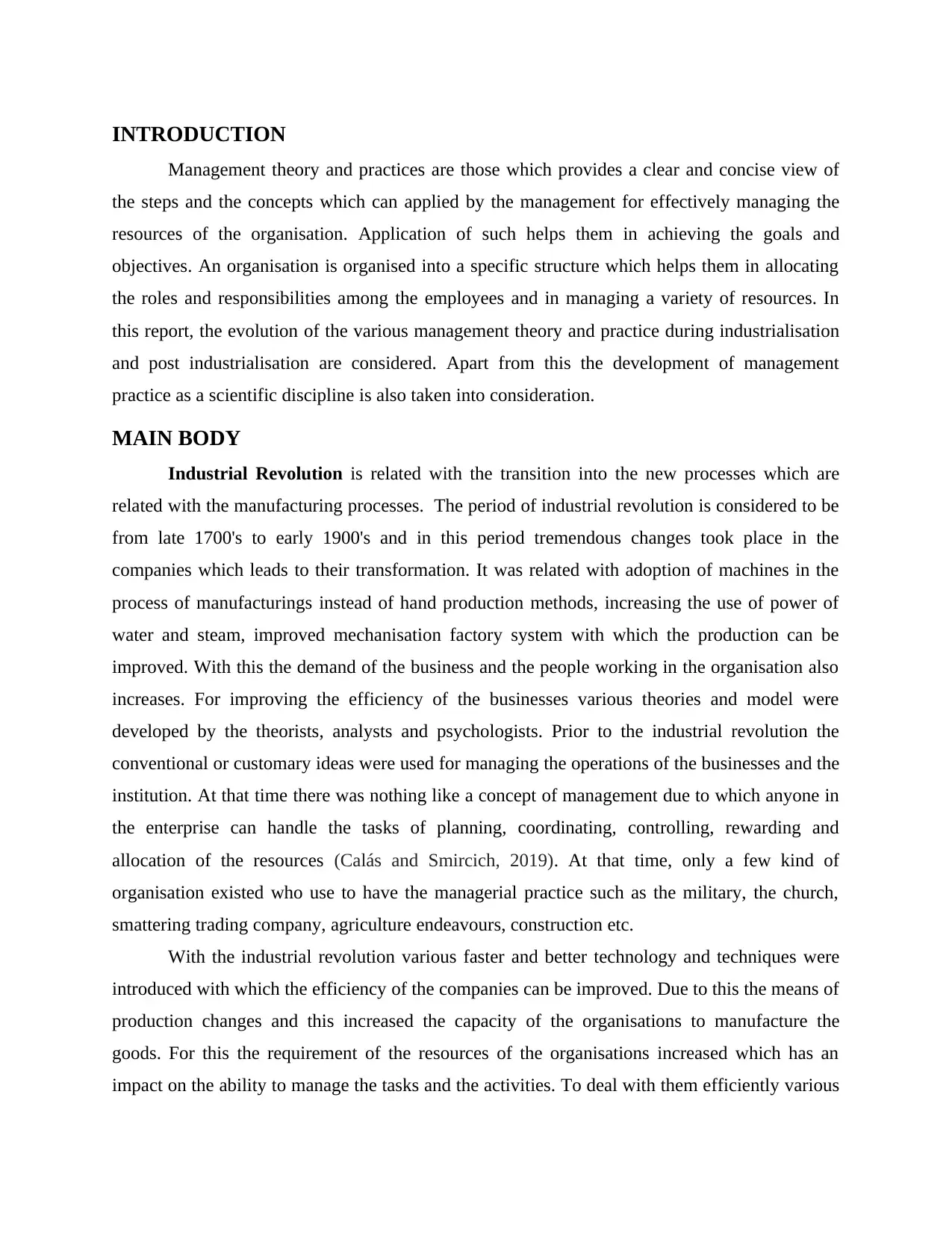
INTRODUCTION
Management theory and practices are those which provides a clear and concise view of
the steps and the concepts which can applied by the management for effectively managing the
resources of the organisation. Application of such helps them in achieving the goals and
objectives. An organisation is organised into a specific structure which helps them in allocating
the roles and responsibilities among the employees and in managing a variety of resources. In
this report, the evolution of the various management theory and practice during industrialisation
and post industrialisation are considered. Apart from this the development of management
practice as a scientific discipline is also taken into consideration.
MAIN BODY
Industrial Revolution is related with the transition into the new processes which are
related with the manufacturing processes. The period of industrial revolution is considered to be
from late 1700's to early 1900's and in this period tremendous changes took place in the
companies which leads to their transformation. It was related with adoption of machines in the
process of manufacturings instead of hand production methods, increasing the use of power of
water and steam, improved mechanisation factory system with which the production can be
improved. With this the demand of the business and the people working in the organisation also
increases. For improving the efficiency of the businesses various theories and model were
developed by the theorists, analysts and psychologists. Prior to the industrial revolution the
conventional or customary ideas were used for managing the operations of the businesses and the
institution. At that time there was nothing like a concept of management due to which anyone in
the enterprise can handle the tasks of planning, coordinating, controlling, rewarding and
allocation of the resources (Calás and Smircich, 2019). At that time, only a few kind of
organisation existed who use to have the managerial practice such as the military, the church,
smattering trading company, agriculture endeavours, construction etc.
With the industrial revolution various faster and better technology and techniques were
introduced with which the efficiency of the companies can be improved. Due to this the means of
production changes and this increased the capacity of the organisations to manufacture the
goods. For this the requirement of the resources of the organisations increased which has an
impact on the ability to manage the tasks and the activities. To deal with them efficiently various
Management theory and practices are those which provides a clear and concise view of
the steps and the concepts which can applied by the management for effectively managing the
resources of the organisation. Application of such helps them in achieving the goals and
objectives. An organisation is organised into a specific structure which helps them in allocating
the roles and responsibilities among the employees and in managing a variety of resources. In
this report, the evolution of the various management theory and practice during industrialisation
and post industrialisation are considered. Apart from this the development of management
practice as a scientific discipline is also taken into consideration.
MAIN BODY
Industrial Revolution is related with the transition into the new processes which are
related with the manufacturing processes. The period of industrial revolution is considered to be
from late 1700's to early 1900's and in this period tremendous changes took place in the
companies which leads to their transformation. It was related with adoption of machines in the
process of manufacturings instead of hand production methods, increasing the use of power of
water and steam, improved mechanisation factory system with which the production can be
improved. With this the demand of the business and the people working in the organisation also
increases. For improving the efficiency of the businesses various theories and model were
developed by the theorists, analysts and psychologists. Prior to the industrial revolution the
conventional or customary ideas were used for managing the operations of the businesses and the
institution. At that time there was nothing like a concept of management due to which anyone in
the enterprise can handle the tasks of planning, coordinating, controlling, rewarding and
allocation of the resources (Calás and Smircich, 2019). At that time, only a few kind of
organisation existed who use to have the managerial practice such as the military, the church,
smattering trading company, agriculture endeavours, construction etc.
With the industrial revolution various faster and better technology and techniques were
introduced with which the efficiency of the companies can be improved. Due to this the means of
production changes and this increased the capacity of the organisations to manufacture the
goods. For this the requirement of the resources of the organisations increased which has an
impact on the ability to manage the tasks and the activities. To deal with them efficiently various
⊘ This is a preview!⊘
Do you want full access?
Subscribe today to unlock all pages.

Trusted by 1+ million students worldwide
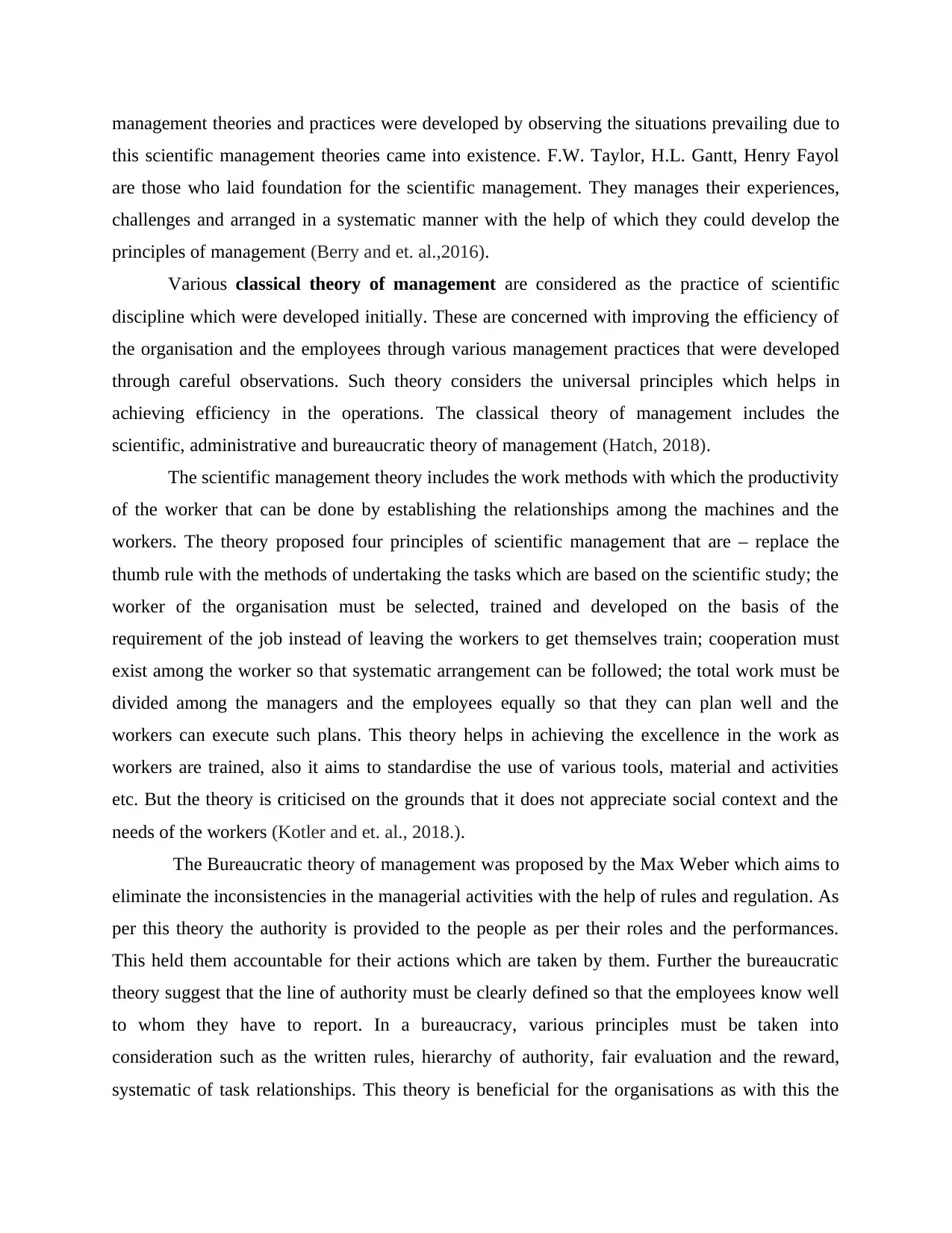
management theories and practices were developed by observing the situations prevailing due to
this scientific management theories came into existence. F.W. Taylor, H.L. Gantt, Henry Fayol
are those who laid foundation for the scientific management. They manages their experiences,
challenges and arranged in a systematic manner with the help of which they could develop the
principles of management (Berry and et. al.,2016).
Various classical theory of management are considered as the practice of scientific
discipline which were developed initially. These are concerned with improving the efficiency of
the organisation and the employees through various management practices that were developed
through careful observations. Such theory considers the universal principles which helps in
achieving efficiency in the operations. The classical theory of management includes the
scientific, administrative and bureaucratic theory of management (Hatch, 2018).
The scientific management theory includes the work methods with which the productivity
of the worker that can be done by establishing the relationships among the machines and the
workers. The theory proposed four principles of scientific management that are – replace the
thumb rule with the methods of undertaking the tasks which are based on the scientific study; the
worker of the organisation must be selected, trained and developed on the basis of the
requirement of the job instead of leaving the workers to get themselves train; cooperation must
exist among the worker so that systematic arrangement can be followed; the total work must be
divided among the managers and the employees equally so that they can plan well and the
workers can execute such plans. This theory helps in achieving the excellence in the work as
workers are trained, also it aims to standardise the use of various tools, material and activities
etc. But the theory is criticised on the grounds that it does not appreciate social context and the
needs of the workers (Kotler and et. al., 2018.).
The Bureaucratic theory of management was proposed by the Max Weber which aims to
eliminate the inconsistencies in the managerial activities with the help of rules and regulation. As
per this theory the authority is provided to the people as per their roles and the performances.
This held them accountable for their actions which are taken by them. Further the bureaucratic
theory suggest that the line of authority must be clearly defined so that the employees know well
to whom they have to report. In a bureaucracy, various principles must be taken into
consideration such as the written rules, hierarchy of authority, fair evaluation and the reward,
systematic of task relationships. This theory is beneficial for the organisations as with this the
this scientific management theories came into existence. F.W. Taylor, H.L. Gantt, Henry Fayol
are those who laid foundation for the scientific management. They manages their experiences,
challenges and arranged in a systematic manner with the help of which they could develop the
principles of management (Berry and et. al.,2016).
Various classical theory of management are considered as the practice of scientific
discipline which were developed initially. These are concerned with improving the efficiency of
the organisation and the employees through various management practices that were developed
through careful observations. Such theory considers the universal principles which helps in
achieving efficiency in the operations. The classical theory of management includes the
scientific, administrative and bureaucratic theory of management (Hatch, 2018).
The scientific management theory includes the work methods with which the productivity
of the worker that can be done by establishing the relationships among the machines and the
workers. The theory proposed four principles of scientific management that are – replace the
thumb rule with the methods of undertaking the tasks which are based on the scientific study; the
worker of the organisation must be selected, trained and developed on the basis of the
requirement of the job instead of leaving the workers to get themselves train; cooperation must
exist among the worker so that systematic arrangement can be followed; the total work must be
divided among the managers and the employees equally so that they can plan well and the
workers can execute such plans. This theory helps in achieving the excellence in the work as
workers are trained, also it aims to standardise the use of various tools, material and activities
etc. But the theory is criticised on the grounds that it does not appreciate social context and the
needs of the workers (Kotler and et. al., 2018.).
The Bureaucratic theory of management was proposed by the Max Weber which aims to
eliminate the inconsistencies in the managerial activities with the help of rules and regulation. As
per this theory the authority is provided to the people as per their roles and the performances.
This held them accountable for their actions which are taken by them. Further the bureaucratic
theory suggest that the line of authority must be clearly defined so that the employees know well
to whom they have to report. In a bureaucracy, various principles must be taken into
consideration such as the written rules, hierarchy of authority, fair evaluation and the reward,
systematic of task relationships. This theory is beneficial for the organisations as with this the
Paraphrase This Document
Need a fresh take? Get an instant paraphrase of this document with our AI Paraphraser
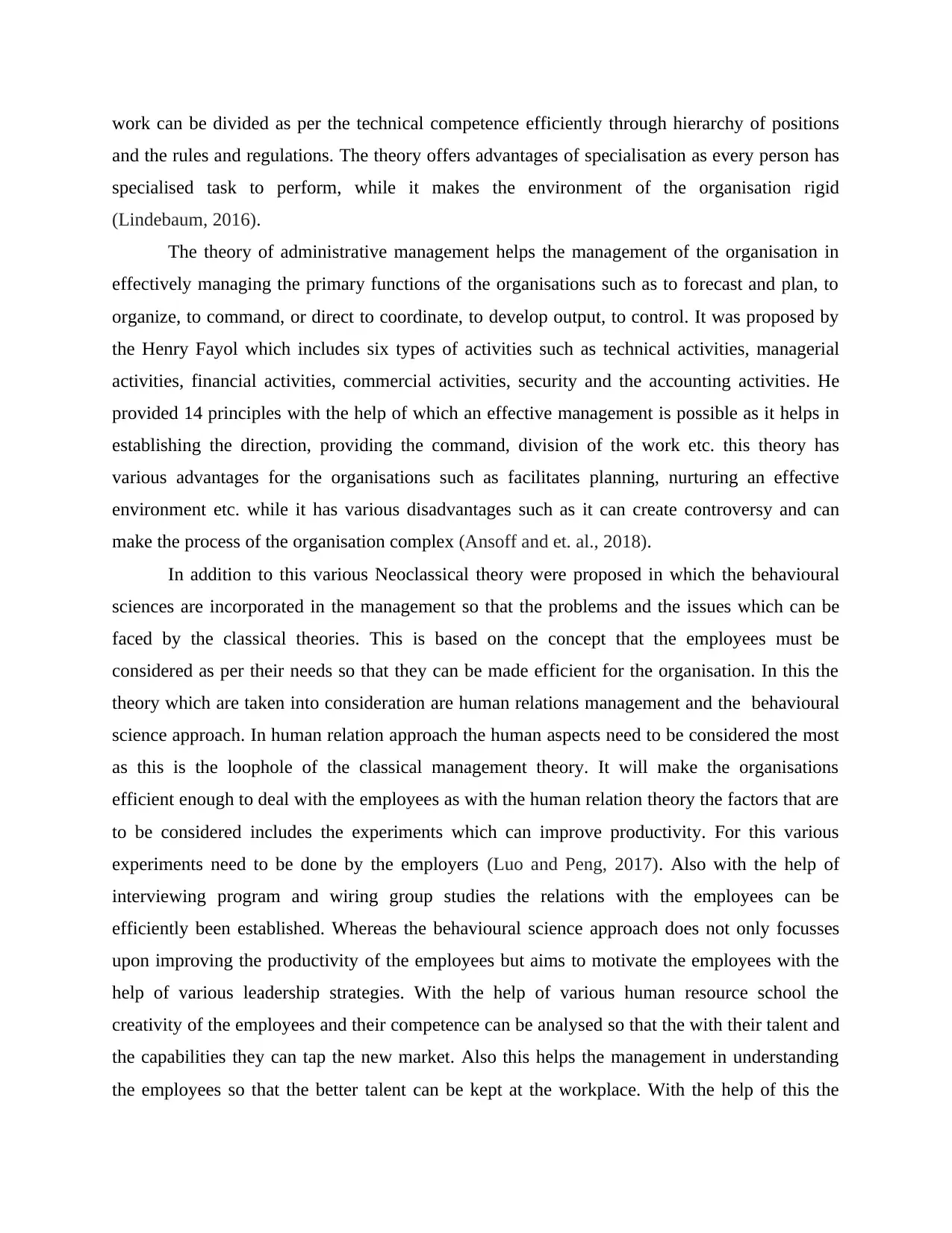
work can be divided as per the technical competence efficiently through hierarchy of positions
and the rules and regulations. The theory offers advantages of specialisation as every person has
specialised task to perform, while it makes the environment of the organisation rigid
(Lindebaum, 2016).
The theory of administrative management helps the management of the organisation in
effectively managing the primary functions of the organisations such as to forecast and plan, to
organize, to command, or direct to coordinate, to develop output, to control. It was proposed by
the Henry Fayol which includes six types of activities such as technical activities, managerial
activities, financial activities, commercial activities, security and the accounting activities. He
provided 14 principles with the help of which an effective management is possible as it helps in
establishing the direction, providing the command, division of the work etc. this theory has
various advantages for the organisations such as facilitates planning, nurturing an effective
environment etc. while it has various disadvantages such as it can create controversy and can
make the process of the organisation complex (Ansoff and et. al., 2018).
In addition to this various Neoclassical theory were proposed in which the behavioural
sciences are incorporated in the management so that the problems and the issues which can be
faced by the classical theories. This is based on the concept that the employees must be
considered as per their needs so that they can be made efficient for the organisation. In this the
theory which are taken into consideration are human relations management and the behavioural
science approach. In human relation approach the human aspects need to be considered the most
as this is the loophole of the classical management theory. It will make the organisations
efficient enough to deal with the employees as with the human relation theory the factors that are
to be considered includes the experiments which can improve productivity. For this various
experiments need to be done by the employers (Luo and Peng, 2017). Also with the help of
interviewing program and wiring group studies the relations with the employees can be
efficiently been established. Whereas the behavioural science approach does not only focusses
upon improving the productivity of the employees but aims to motivate the employees with the
help of various leadership strategies. With the help of various human resource school the
creativity of the employees and their competence can be analysed so that the with their talent and
the capabilities they can tap the new market. Also this helps the management in understanding
the employees so that the better talent can be kept at the workplace. With the help of this the
and the rules and regulations. The theory offers advantages of specialisation as every person has
specialised task to perform, while it makes the environment of the organisation rigid
(Lindebaum, 2016).
The theory of administrative management helps the management of the organisation in
effectively managing the primary functions of the organisations such as to forecast and plan, to
organize, to command, or direct to coordinate, to develop output, to control. It was proposed by
the Henry Fayol which includes six types of activities such as technical activities, managerial
activities, financial activities, commercial activities, security and the accounting activities. He
provided 14 principles with the help of which an effective management is possible as it helps in
establishing the direction, providing the command, division of the work etc. this theory has
various advantages for the organisations such as facilitates planning, nurturing an effective
environment etc. while it has various disadvantages such as it can create controversy and can
make the process of the organisation complex (Ansoff and et. al., 2018).
In addition to this various Neoclassical theory were proposed in which the behavioural
sciences are incorporated in the management so that the problems and the issues which can be
faced by the classical theories. This is based on the concept that the employees must be
considered as per their needs so that they can be made efficient for the organisation. In this the
theory which are taken into consideration are human relations management and the behavioural
science approach. In human relation approach the human aspects need to be considered the most
as this is the loophole of the classical management theory. It will make the organisations
efficient enough to deal with the employees as with the human relation theory the factors that are
to be considered includes the experiments which can improve productivity. For this various
experiments need to be done by the employers (Luo and Peng, 2017). Also with the help of
interviewing program and wiring group studies the relations with the employees can be
efficiently been established. Whereas the behavioural science approach does not only focusses
upon improving the productivity of the employees but aims to motivate the employees with the
help of various leadership strategies. With the help of various human resource school the
creativity of the employees and their competence can be analysed so that the with their talent and
the capabilities they can tap the new market. Also this helps the management in understanding
the employees so that the better talent can be kept at the workplace. With the help of this the
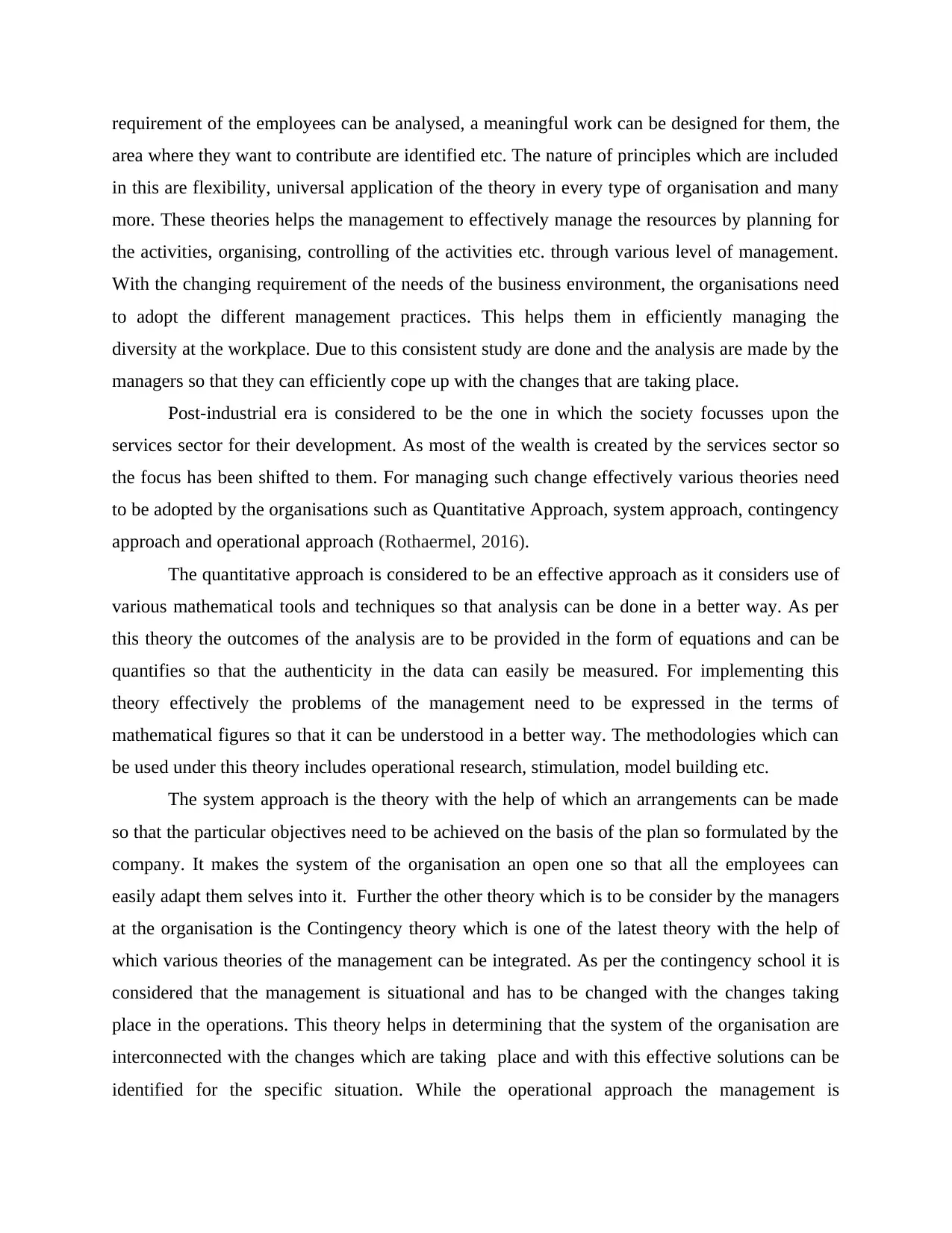
requirement of the employees can be analysed, a meaningful work can be designed for them, the
area where they want to contribute are identified etc. The nature of principles which are included
in this are flexibility, universal application of the theory in every type of organisation and many
more. These theories helps the management to effectively manage the resources by planning for
the activities, organising, controlling of the activities etc. through various level of management.
With the changing requirement of the needs of the business environment, the organisations need
to adopt the different management practices. This helps them in efficiently managing the
diversity at the workplace. Due to this consistent study are done and the analysis are made by the
managers so that they can efficiently cope up with the changes that are taking place.
Post-industrial era is considered to be the one in which the society focusses upon the
services sector for their development. As most of the wealth is created by the services sector so
the focus has been shifted to them. For managing such change effectively various theories need
to be adopted by the organisations such as Quantitative Approach, system approach, contingency
approach and operational approach (Rothaermel, 2016).
The quantitative approach is considered to be an effective approach as it considers use of
various mathematical tools and techniques so that analysis can be done in a better way. As per
this theory the outcomes of the analysis are to be provided in the form of equations and can be
quantifies so that the authenticity in the data can easily be measured. For implementing this
theory effectively the problems of the management need to be expressed in the terms of
mathematical figures so that it can be understood in a better way. The methodologies which can
be used under this theory includes operational research, stimulation, model building etc.
The system approach is the theory with the help of which an arrangements can be made
so that the particular objectives need to be achieved on the basis of the plan so formulated by the
company. It makes the system of the organisation an open one so that all the employees can
easily adapt them selves into it. Further the other theory which is to be consider by the managers
at the organisation is the Contingency theory which is one of the latest theory with the help of
which various theories of the management can be integrated. As per the contingency school it is
considered that the management is situational and has to be changed with the changes taking
place in the operations. This theory helps in determining that the system of the organisation are
interconnected with the changes which are taking place and with this effective solutions can be
identified for the specific situation. While the operational approach the management is
area where they want to contribute are identified etc. The nature of principles which are included
in this are flexibility, universal application of the theory in every type of organisation and many
more. These theories helps the management to effectively manage the resources by planning for
the activities, organising, controlling of the activities etc. through various level of management.
With the changing requirement of the needs of the business environment, the organisations need
to adopt the different management practices. This helps them in efficiently managing the
diversity at the workplace. Due to this consistent study are done and the analysis are made by the
managers so that they can efficiently cope up with the changes that are taking place.
Post-industrial era is considered to be the one in which the society focusses upon the
services sector for their development. As most of the wealth is created by the services sector so
the focus has been shifted to them. For managing such change effectively various theories need
to be adopted by the organisations such as Quantitative Approach, system approach, contingency
approach and operational approach (Rothaermel, 2016).
The quantitative approach is considered to be an effective approach as it considers use of
various mathematical tools and techniques so that analysis can be done in a better way. As per
this theory the outcomes of the analysis are to be provided in the form of equations and can be
quantifies so that the authenticity in the data can easily be measured. For implementing this
theory effectively the problems of the management need to be expressed in the terms of
mathematical figures so that it can be understood in a better way. The methodologies which can
be used under this theory includes operational research, stimulation, model building etc.
The system approach is the theory with the help of which an arrangements can be made
so that the particular objectives need to be achieved on the basis of the plan so formulated by the
company. It makes the system of the organisation an open one so that all the employees can
easily adapt them selves into it. Further the other theory which is to be consider by the managers
at the organisation is the Contingency theory which is one of the latest theory with the help of
which various theories of the management can be integrated. As per the contingency school it is
considered that the management is situational and has to be changed with the changes taking
place in the operations. This theory helps in determining that the system of the organisation are
interconnected with the changes which are taking place and with this effective solutions can be
identified for the specific situation. While the operational approach the management is
⊘ This is a preview!⊘
Do you want full access?
Subscribe today to unlock all pages.

Trusted by 1+ million students worldwide
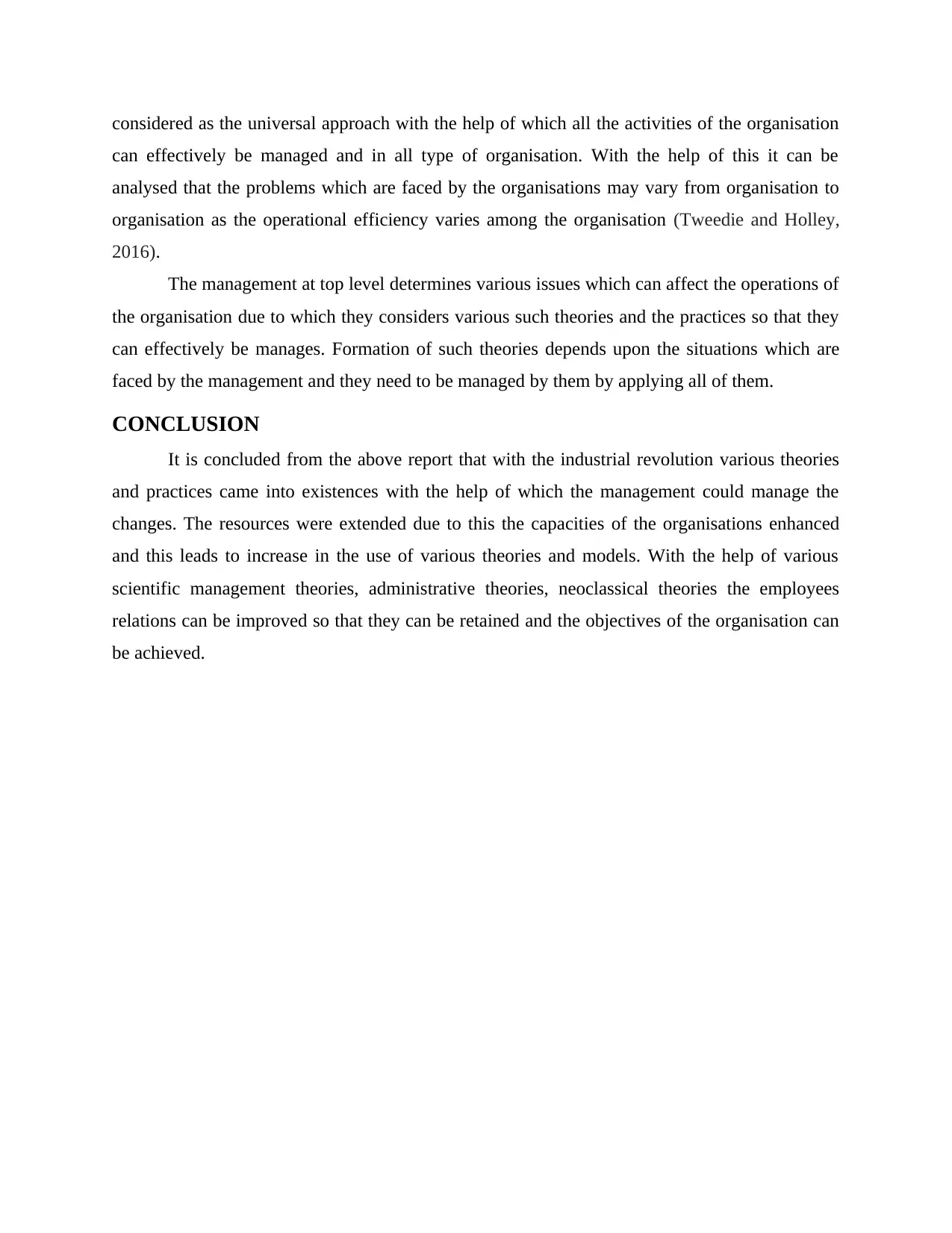
considered as the universal approach with the help of which all the activities of the organisation
can effectively be managed and in all type of organisation. With the help of this it can be
analysed that the problems which are faced by the organisations may vary from organisation to
organisation as the operational efficiency varies among the organisation (Tweedie and Holley,
2016).
The management at top level determines various issues which can affect the operations of
the organisation due to which they considers various such theories and the practices so that they
can effectively be manages. Formation of such theories depends upon the situations which are
faced by the management and they need to be managed by them by applying all of them.
CONCLUSION
It is concluded from the above report that with the industrial revolution various theories
and practices came into existences with the help of which the management could manage the
changes. The resources were extended due to this the capacities of the organisations enhanced
and this leads to increase in the use of various theories and models. With the help of various
scientific management theories, administrative theories, neoclassical theories the employees
relations can be improved so that they can be retained and the objectives of the organisation can
be achieved.
can effectively be managed and in all type of organisation. With the help of this it can be
analysed that the problems which are faced by the organisations may vary from organisation to
organisation as the operational efficiency varies among the organisation (Tweedie and Holley,
2016).
The management at top level determines various issues which can affect the operations of
the organisation due to which they considers various such theories and the practices so that they
can effectively be manages. Formation of such theories depends upon the situations which are
faced by the management and they need to be managed by them by applying all of them.
CONCLUSION
It is concluded from the above report that with the industrial revolution various theories
and practices came into existences with the help of which the management could manage the
changes. The resources were extended due to this the capacities of the organisations enhanced
and this leads to increase in the use of various theories and models. With the help of various
scientific management theories, administrative theories, neoclassical theories the employees
relations can be improved so that they can be retained and the objectives of the organisation can
be achieved.
Paraphrase This Document
Need a fresh take? Get an instant paraphrase of this document with our AI Paraphraser
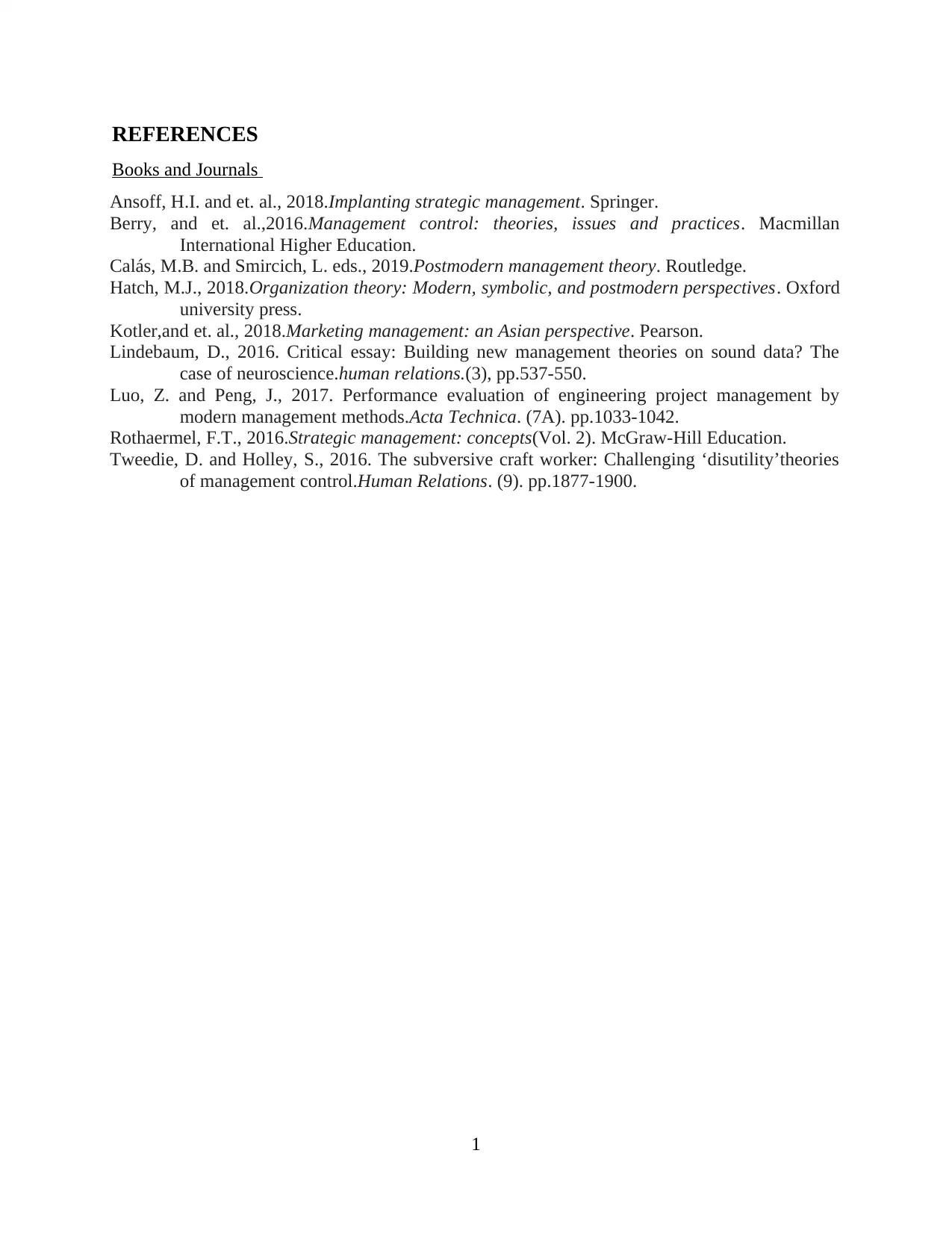
REFERENCES
Books and Journals
Ansoff, H.I. and et. al., 2018.Implanting strategic management. Springer.
Berry, and et. al.,2016.Management control: theories, issues and practices. Macmillan
International Higher Education.
Calás, M.B. and Smircich, L. eds., 2019.Postmodern management theory. Routledge.
Hatch, M.J., 2018.Organization theory: Modern, symbolic, and postmodern perspectives. Oxford
university press.
Kotler,and et. al., 2018.Marketing management: an Asian perspective. Pearson.
Lindebaum, D., 2016. Critical essay: Building new management theories on sound data? The
case of neuroscience.human relations.(3), pp.537-550.
Luo, Z. and Peng, J., 2017. Performance evaluation of engineering project management by
modern management methods.Acta Technica. (7A). pp.1033-1042.
Rothaermel, F.T., 2016.Strategic management: concepts(Vol. 2). McGraw-Hill Education.
Tweedie, D. and Holley, S., 2016. The subversive craft worker: Challenging ‘disutility’theories
of management control.Human Relations. (9). pp.1877-1900.
1
Books and Journals
Ansoff, H.I. and et. al., 2018.Implanting strategic management. Springer.
Berry, and et. al.,2016.Management control: theories, issues and practices. Macmillan
International Higher Education.
Calás, M.B. and Smircich, L. eds., 2019.Postmodern management theory. Routledge.
Hatch, M.J., 2018.Organization theory: Modern, symbolic, and postmodern perspectives. Oxford
university press.
Kotler,and et. al., 2018.Marketing management: an Asian perspective. Pearson.
Lindebaum, D., 2016. Critical essay: Building new management theories on sound data? The
case of neuroscience.human relations.(3), pp.537-550.
Luo, Z. and Peng, J., 2017. Performance evaluation of engineering project management by
modern management methods.Acta Technica. (7A). pp.1033-1042.
Rothaermel, F.T., 2016.Strategic management: concepts(Vol. 2). McGraw-Hill Education.
Tweedie, D. and Holley, S., 2016. The subversive craft worker: Challenging ‘disutility’theories
of management control.Human Relations. (9). pp.1877-1900.
1
1 out of 8
Related Documents
Your All-in-One AI-Powered Toolkit for Academic Success.
+13062052269
info@desklib.com
Available 24*7 on WhatsApp / Email
![[object Object]](/_next/static/media/star-bottom.7253800d.svg)
Unlock your academic potential
Copyright © 2020–2025 A2Z Services. All Rights Reserved. Developed and managed by ZUCOL.





